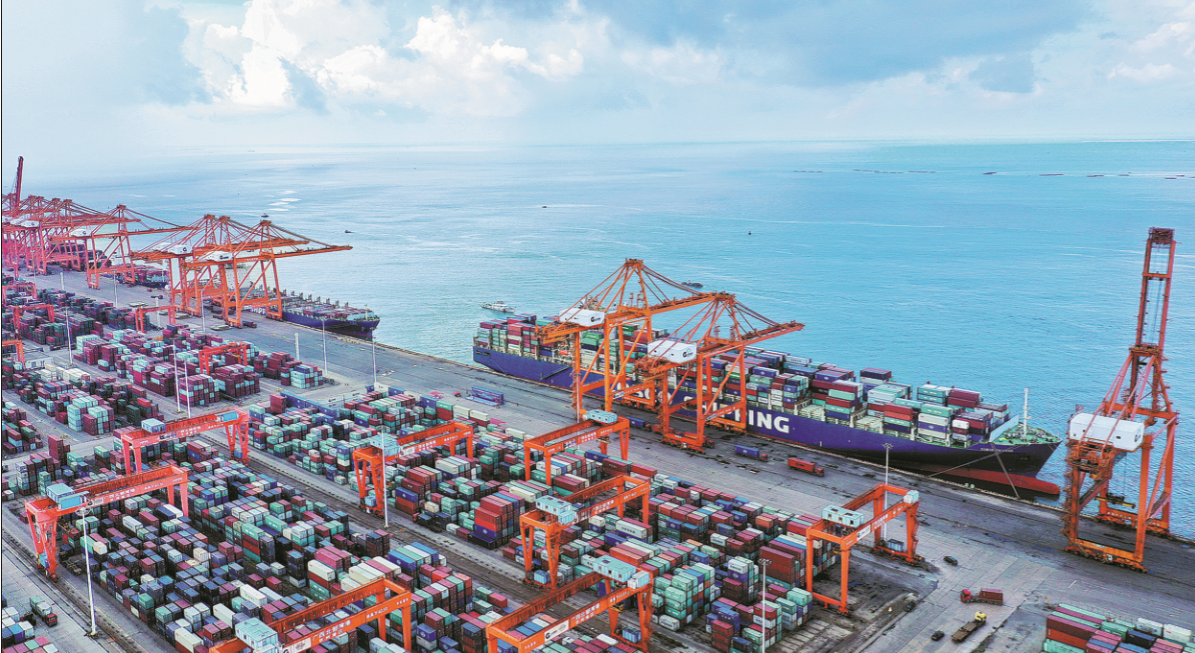



China COSCO Shipping's Zhongyuantaicang container ship, with a tonnage exceeding 10,000 tons, docks at the Beibu Gulf Port in Qinzhou, Guangxi Zhuang autonomous region. [Photo provided to China Daily]
Plan combines weighty role of domestic consumers with continual opening-up
China's new "dual-circulation" development model will provide the engine for the country's future economic success and could herald a new era of globalization, according to experts.
The model, which combines the forces of China's domestic economy and international economic engagement, is set to be central to China's 14th Five-Year Plan (2021-25).
It was first raised by Xi Jinping, general secretary of the Communist Party of China Central Committee, at a high-level CPC meeting in May.
Stephen Roach, a leading US economist and senior fellow at Yale University's Jackson Institute for Global Affairs, called it a "very important strategic concept".
"It underscores China's focus on both the internal and external elements of its growth strategy," he said. "Success will be measured on how well these two sources of support work together rather than in isolation from one another."
Edward Tse, CEO and founder of Gao Feng Advisory, a management consultancy, believes that dual circulation is a concept that fully embraces the emergence of "globalization 2.0".
He said globalization 1.0 was the Made in China era of China being the center of supply, while now, with a huge new middle-income group, the nation is a center of demand as well as supply.
"This is the new pattern of dual cycles of global supply and demand which epitomizes a new era of globalization," he said.
China's dual circulation strategy, in which the domestic economy is the mainstay and the domestic and international economies complement each other, has already attracted much international interest and comment.
At its heart, it acknowledges the importance of domestic consumption in the next phase of the country's economic development. China is set to have 600 million middle-income consumers by the middle of this decade, according to management consultants McKinsey &Co. The new development paradigm also emphasizes the need for greater indigenous technological innovation and the strengthening of domestic supply chains.
At the same time, the model recognizes the importance of the international economy in China's development, including further opening-up of the economy to foreign companies.
Xi has said the aim is to "fully bring out the advantage of its (China's) super-large market scale and the potential of domestic demand to establish a new development pattern featuring domestic and international circulations that complement each other."
Zhu Ning, a professor of finance and also deputy dean at the Shanghai Advanced Institute of Finance, believes the new model is right to recognize the role of domestic consumption in China's future development.
"Consumption now contributes more than half of China's economic growth, and the domestic market is growing faster than that of many developed economies," he said.
However, he added, "The dual circulation aspect of this has to be borne in mind at all times. It would be counterproductive if China gave up on opening-up and solely focused instead on its domestic economy."
Hao Hong, managing director and head of research at BOCOM International Securities, based in Hong Kong, said the strategy recognizes a major shift taking place in China's economy.
"It is about the changing role of China's production capacity and the need to move it to satisfy the new domestic demand and not just that from abroad. You can see this already with car production and the manufacture of iPhones. Increasingly they are being made in China to meet domestic demand," he said.

Customers buy foods in a supermarket in Mujie village, Guizhou province, on Nov 25, 2020. [Photo/Xinhua]
Similar advantage
Keyu Jin, an associate professor of economics at the London School of Economics, said China has an advantage similar to that of the United States in having a big domestic market.
"China enjoys the advantage of having a very large domestic economy, so that much of its growth can be generated internally. This is also the case in the United States," she said.
The new development model also comes after trade tensions between the US and China, including attempts to deny China access to components such as semiconductors.
Louis Kuijs, head of Asia for Oxford Economics, an economics research consultancy, said it is therefore important for China to reinforce its domestic supply chains and develop more of its own technology.
"Achieving self-sufficiency in technology is an important part of the new policy agenda. The challenge for China is to make this sustainable. If it is too much State-directed and attempted using subsidies, it will not be so easy to achieve."
Tom Rafferty, regional director for Asia for The Economist Intelligence Unit, a global business intelligence organization, said China is not unique in Asia in wanting to be more self-sufficient.
Self-sufficient approach
He pointed out that India has launched a "self-reliance" movement to address its supply chain vulnerabilities, and Indonesia is following import substitution policies to support domestic industry.
"In China, the emerging focus on self-sufficiency comes amid strained relations with the US. We see these concerns translating into greater focus on bolstering domestic demand, especially household spending, while efforts to move up the value chain will create opportunities in the high-end technology, energy and healthcare sectors," he said.
He believes that one trend that may result from this could be foreign companies having to localize their business operations in China and in Asia generally.
"It will mean more investment in on-the-ground research and development, expansion in local staffing and operations, and the cultivation of deeper regional partnerships and collaborations. Doing this, while managing calls for 'reshoring' in home markets, will require significant strategic and political dexterity," he said.
Jing Ulrich, vice-chairman of global banking and the Asia-Pacific at investment bank JP Morgan, said dual circulation was the right strategy for China to pursue following a "remarkable V-shaped recovery" from the pandemic.
"The stage will be set at the start of the next five-year plan for a continuation of efforts to transform the economy toward sustained, high-quality growth," she said.
Tse of Gao Feng Advisory, who is one of China's best-known management consultants, said China might have to rely heavily on its own domestic market during the early part of the next five-year plan.
"The pandemic has had a huge dampening effect on the economy of many Western countries, while China is experiencing a quick economic recovery after it has effectively contained the pandemic," he said.
"As the external circulation may not get back to its full throttle anytime soon, the internal circulation becomes very important," Tse added.
Roach, a former chief economist and Asia chairman of investment bank Morgan Stanley, is convinced the dual circulation strategy has the potential to deliver China's long-term economic goals.
As a modern advanced economy, China "will be successful in drawing on dual circulation as the means toward realizing its key strategic objectives", he said.

 Award-winning photos show poverty reduction achievements in NE China's Jilin province
Award-winning photos show poverty reduction achievements in NE China's Jilin province People dance to greet advent of New Year in Ameiqituo Town, Guizhou
People dance to greet advent of New Year in Ameiqituo Town, Guizhou Fire brigade in Shanghai holds group wedding
Fire brigade in Shanghai holds group wedding Tourists enjoy ice sculptures in Datan Town, north China
Tourists enjoy ice sculptures in Datan Town, north China Sunset scenery of Dayan Pagoda in Xi'an
Sunset scenery of Dayan Pagoda in Xi'an Tourists have fun at scenic spot in Nanlong Town, NW China
Tourists have fun at scenic spot in Nanlong Town, NW China Harbin attracts tourists by making best use of ice in winter
Harbin attracts tourists by making best use of ice in winter In pics: FIS Alpine Ski Women's World Cup Slalom
In pics: FIS Alpine Ski Women's World Cup Slalom Black-necked cranes rest at reservoir in Lhunzhub County, Lhasa
Black-necked cranes rest at reservoir in Lhunzhub County, Lhasa China's FAST telescope will be available to foreign scientists in April
China's FAST telescope will be available to foreign scientists in April